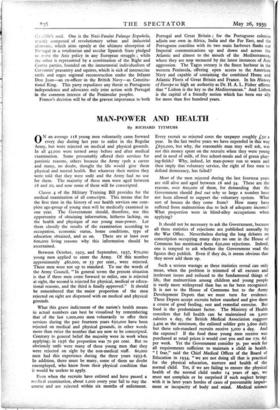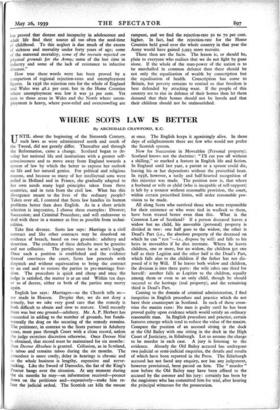MAN-POWER AND HEALTH
By RICHARD TITMUSS
ON an average 118 young men voluntarily came forward every day during last year to enlist in the Regular Army, but were rejected on medical and physical grounds. In all 42,000 were turned away before and after medical examination. Some presumably offered their services for patriotic reasons, others because the Army spelt a career and many, no doubt, thought the life would give them physical and mental health. But whatever their motive they were told that they were unfit and the Army had no use for them. The majority of these men were aged between 18 and 20, and now some of them will be conscripted.
Clause 4 of the Military Training Bill provides for the medical examination of all conscripts. This means that for the first time in the history of our health services one com- plete age-group of young men will be medically examined in one year. The Government should, therefore, use this opportunity of obtaining information, hitherto lacking, on the health and physique of our young man-power. Let them classify the results of the examination according to occupation, economic status, home conditions, type of education obtained, and so on. There are at least over 600,000 living reasons why this information should be ascertained.
Between October, 1925, and September, 1937, 87o,000 young men applied to enter the Army. Of this number approximately 480,000, or 55 per cent., were rejected. These men were not up to standard. To use the words of the Army Council, "In general terms the present situation is that if three men come forward to enlist, one is rejected at sight, the second is rejected for physical, medical or educa- tional reasons, and the third is finally approved." It should be remembered that the major proportion of the men rejected on sight are dispensed with on medical and physical grounds.
What this grave indictment of the nation's health means in actual numbers can best be visualised by remembering that of the last r,000,000 men voluntarily to offer their services during the past fourteen years 65o,000 have been rejected on medical and physical grounds, in other words more than twice the number that are now to be conscripted. Contrary to general belief the majority were in work when applying; in 1936 the proportion was 70 per cent. But so obviously unfit were many of these young men that they were rejected on sight by the non-medical staff. 6o,000 men had this experience during the three years 1933-6. In addition, there must be many, some of them no doubt unemployed, who know from their physical condition that it would be useless to apply.
Even when the recruits have enlisted and have passed a medical examination, about 5,000 every year fail to stay the course and are rejected within six months of enlistment. Every recruit so rejected costs the taxpayer roughly £50 a year. In the last twelve years we have expended in this way L65o,000, but why, the reasonable man may well ask, was not this money spent on the recruits when they were young and in need of milk, of free school-meals and of green play- ing-fields? Why, indeed, let man-power run to waste and then imply that voluntary service, the right of free men to defend democracy, has failed?
Most of the men rejected during the last fourteen years are still alive and aged between 18 and 34. These are the reasons, over 600,000 of them, for demanding that the Government should find out why so large a number have not been allowed to support the voluntary system. What sort of houses do they come from? How many have suffered from malnutrition due to lack of adequate income? What proportion were in blind-alley occupations when applying?
It should not be necessary to ask the Government, because all these statistics of rejections are published annually by the War Office. Nevertheless during the long debates on conscription occupying many days no one in the House of Commons has mentioned these 65o,000 rejections. Indeed, one is tempted to ask whether the Government read the figures they publish. Even if they do, it seems obvious that they never add them up.
Such a serious wastage as these Statistics reveal can only mean, when the problem is trimmed of all excuses and irrelevant issues and reduced to the fundamental things of life, that malnutrition among children and young people is vastly more widespread than has so far been recognised. It is not to the House of Commons but to the Army Development Depots that we must turn for evidence. These Depots accept recruits below standard and give them a course of good feeding, rest and remedial exercise. But food is the predominant factor. The Ministry of Health considers that full health can be maintained on 3,000 calories a day, the British Medical Association suggests 3,400 as the minimum, the enlisted soldier gets 3,600 daily but these sub-standard recruits receive 5,000 a day. And the expense? If the food these young men receive was purchased at retail prices it would cost you and me 17s. 6d. per week. Yet the Government consider 3s. per week for all requirements sufficient to maintain a child in health. "I fear," said the Chief Medical Officer of the Board of Education in 1934, "we are not doing all that is practical for the physical education, nurture and health of the normal child. Yet, if we are failing to ensure the physical health of the normal child under 54 years of age, we must not complain or be surprised if such neglect brings with it in later years hordes of cases of preventable impair- ment or incapacity of body and mind. Medical science has proved that disease and incapacity in adolescence and adult life find their source all too often the seed-time of childhood. To this neglect is due much of the excess of sickness and mortality under forty years of age; some of the maternal mortality; some of the recruits rejected on physical grounds for the Army; some of the lost time in industry and some of the lack of resistance to infective diseases."
How true these words were has been proved by a comparison of regional rejection-rates and unemployment figures. In 1936 the rejection rate for the whole of England and Wales was 48.2 per cent. but in the Home Counties where unemployment was low it was 32 per cent. Yet turn to those areas in Wales and the North where unem- ployment is heavy, where poor-relief and overcrowding are rampant, and we find the rejection-rate 50 to 70 per cent. higher. In fact, had the rejection-rate for the Home Counties held good over the whole country in that year the Army would have gained 5,993 more recruits.
These then are the facts. The lesson is, or should be, plain to everyone who realises that we do not fight by guns alone. If the whole of the man-power of the nation is to be marshalled in common defence then there should be not only the equalisation of wealth by conscription but the equalisation of health. Conscription has come to Britain, but poverty remains to remind us that freedom is best defended by attacking want. If the people of this country are to rise in defence of their homes then let them demand that their homes should not be hovels and that their children should not be malnourished.



























































 Previous page
Previous page